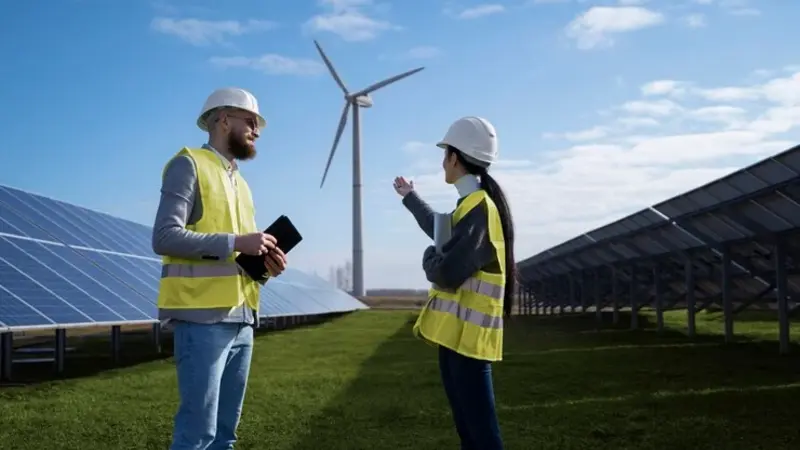The transition to renewable energy is no longer a choice but a necessity. With climate change intensifying and fossil fuel reserves dwindling, the world must pivot towards sustainable energy solutions. Renewable energy sources like solar, wind, hydro, and biomass offer not only environmental benefits but also economic opportunities and energy security.
The Rise of Solar Power
Unleashing the Power of the Sun
Solar energy, harnessing the sun’s rays, has become a frontrunner in the renewable energy race. Its appeal lies in its ubiquity and the decreasing cost of solar panels. Households and businesses alike are adopting solar power to reduce electricity bills and carbon footprints. Innovative technologies, such as photovoltaic cells and concentrated solar power systems, are driving this adoption, making solar one of the most promising and scalable green energy options available today.
Advantages of Solar Energy
The benefits of solar power are manifold. It produces no greenhouse gases during operation, requires little maintenance once installed, and can be deployed at scale or tailored for smaller, off-grid applications. Governments worldwide are supporting solar power through incentives and subsidies, recognizing its role in achieving carbon neutrality. Additionally, platforms like power to choose dallas are empowering consumers by providing comparisons of energy providers, facilitating informed decisions and further accelerating the adoption of solar energy options.
Wind Energy: Harnessing Nature’s Breath
The Mechanics of Wind Power
Wind energy utilizes the kinetic energy of wind to turn turbines that generate electricity. This sector has witnessed substantial growth, particularly in regions with abundant wind resources. Offshore wind farms, benefiting from stronger and more consistent winds, are becoming increasingly common and contribute significantly to national energy grids.
Environmental and Economic Benefits of Wind Energy
Wind power is remarkably efficient in terms of space and energy output. It generates large amounts of electricity without the emission of pollutants or greenhouse gases. Economically, it creates jobs in manufacturing, installation, and maintenance, while also generating energy locally, reducing reliance on imported fuels.
Hydroelectric Power: A Time-Tested Resource
The Principle of Hydroelectric Energy
Hydroelectric power, generated by the movement of water through turbines, is one of the oldest and most reliable forms of energy. Large-scale dams and small-run-of-the-river plants are the two main types of hydroelectric facilities, each playing a crucial role in national energy strategies.
Sustainable Aspects of Hydroelectric Power
While there are environmental concerns regarding large dams, hydroelectric power does not produce air pollution or toxic by-products. It offers a consistent and controllable source of energy, capable of adjusting to demand fluctuations more quickly than fossil-fuel power stations.
Biomass Energy: Organic Materials as Fuel
Turning Waste into Power
Biomass energy involves using organic materials, such as plant waste and manure, to produce heat or electricity. This method not only helps manage waste but also produces energy from materials that would otherwise decompose and release methane, a potent greenhouse gas.
Biomass for a Circular Economy
The use of biomass supports a circular economy, promoting waste reduction and resource efficiency. By converting agricultural, industrial, and domestic waste into energy, biomass plants can significantly reduce landfill use and greenhouse gas emissions, contributing to a cleaner, more sustainable environment.
The Future of Renewable Energy
Innovations and Trends
The future of renewable energy is bright and driven by continuous technological advancements. Innovations such as floating solar farms enhanced geothermal systems, and advanced bioenergy technologies promise to increase efficiency and reduce the costs of renewable energy sources. Moreover, the integration of energy storage solutions, like batteries and other energy-storing technologies, is solving the intermittency issues associated with renewables.
Global Impact and Policy Directions
As countries invest more in renewable energy, global policies are also shifting. International collaborations and agreements are focusing on reducing carbon emissions and promoting sustainability. By investing in renewable infrastructure and adopting supportive policies, nations are not only addressing environmental challenges but also enhancing their energy independence and security.
Conclusion: A Call for Action
The transition to renewable energy is essential for a sustainable future. Each source of renewable energy offers unique benefits, and together, they provide a robust solution to the world’s energy and environmental challenges. Embracing renewable energy is not just an environmental imperative but also an economic opportunity and a pathway to a healthier, more sustainable world. The time for action is now, and every step towards renewable energy is a step towards a safer and greener planet.
